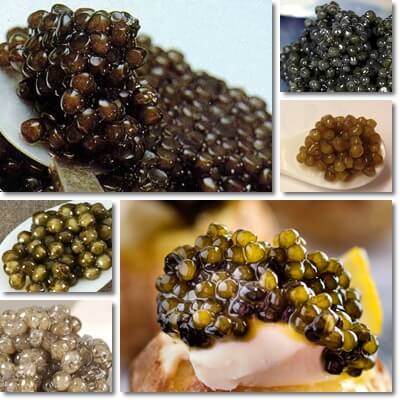What exactly is caviar? Caviar is essentially fish eggs or roe. Authentic caviar is made exclusively from sturgeon eggs or roe. Although there are over 25 different species, only the eggs from 3 species of sturgeon were traditionally used for the production of caviar: Beluga, Sevruga and Ossetra sturgeon. Caviar is typically only lightly salted to improve the taste experience, but also to help prolong the shelf life of the eggs. However, once you open the seal of any fish product, caviar included, it’s imperative you store it in the refrigerator so it doesn’t spoil. In the end, it’s still fish and caution is required with regards to storage conditions.
Why is caviar only from sturgeon?
The main reason why caviar is made only from sturgeon roe has to do with upholding tradition and staying true to the original recipe. Caviar was only made from the roe of sturgeon species found in the Black Sea and Caspian Sea, notably Beluga, Sevruga and Ossetra. But the roe is no longer sourced from fish in the wild since most sturgeon species are currently endangered. Instead, all sturgeon eggs used for caviar making are now being sourced exclusively from farmed sturgeon. This is being done in an effort to both uphold tradition by sticking to the original recipe in order to offer an authentic product and comply with international legislation that forbids sturgeon fishing in the wild so that populations may recover.

At the same time, know that not all types of caviar are made just from sturgeon. There are similar products known as ‘affordable caviar’ or ‘caviar imitation’ that are made from fish eggs other than sturgeon. There’s salmon caviar, one of the most popular of the affordable types, recognizable thanks to the bright red-orange color of the salmon eggs. There’s also paddlefish caviar, lumpfish, trout, cod, whitefish and even some vegetarian options such as caviar made from seaweed.
What does caviar look like?
Caviar, as in the original thing, is typically medium to dark grey to black in color, jelly-like, with a pearly sheen. Color essentially depends on the species of sturgeon the fish eggs are sourced from, age of the fish, diet and other factors. Ossetra caviar is typically grey-brown. There’s also a variety of golden Ossetra caviar which is more of a golden brown with olive undertones than actual golden. The price for golden Osetra caviar was, at one point, around 7-8000 dollars per kilogram. Sevruga caviar is typically medium to dark gray in color and the eggs are smaller in size. Sevruga caviar used to cost around 7-8000 dollars per kilogram.
Beluga caviar is characterized by larger eggs that range in color from light gray to dark gray, almost black. Eggs from younger fish are darker in color, whereas eggs from older fish are increasingly lighter. It’s also the most expensive type, with a price of around 10 000 dollars per kilogram. Almas caviar is a rare, golden-colored type from albino Beluga that is double or triple the price of regular Beluga and likely the most expensive in the world. Just as expensive is caviar from reserves set aside years ago for, well, royalty mostly. Typically, the older the caviar, the more exquisite and less ‘fishy’ and more nuanced its taste and the higher its price. Contrary to popular belief, real caviar isn’t red. If it’s red, it’s salmon, trout, cod or dyed lumpfish, not authentic sturgeon caviar.

What does caviar taste like?
Whether it’s sturgeon, salmon or lumpfish, caviar taste should be pleasant, fine, exquisite even. Caviar is made by separating the fish eggs. So, when you eat it, you should feel the individual eggs rolling around in the mouth. Despite their jelly-like appearance, the eggs are firm and smooth and pop in the mouth when you eat them which makes for a wonderful taste experience. Caviar tastes rich, faintly sweet, somewhat buttery or nutty if it’s older, quite exquisite, but not oily and definitely not fishy in a bad way. Caviar has a more refined flavor, a pleasant fish taste with sea notes and a slight saltiness to it reminiscent of the taste of oysters.
If your caviar tastes unpleasant in the sense that it’s overtly fishy, maybe even a little off even for a fish product or downright salty, then it’s likely a low quality product. Also, caviar or even imitations from salmon, whitefish, lumpfish or other fish should not be heavily seasoned, just lightly salted. Strong flavors, whether from spices or condiments, may be used to mask an off taste and pass a subpar product for a delicacy.
Caviar nutritional information
The most relevant nutrition facts for caviar include:
– high sodium content of up to 200-250 mg or more per tablespoon (16 g a tablespoon);
– high fat and high protein content: 2.5-3 g of fat and 3-4 g of protein per tablespoon;
– high-cholesterol: 75-95 mg of cholesterol per tablespoon;
– low carbohydrate content: around 0.5-0.6 g per tablespoon;
– moderate energetic value: around 40-45 kilocalories per tablespoon;
– 145-200 IU of vitamin A or around 5% recommended daily intake for an average adult;
– 10% RDI of vitamin D;
– 50-140% RDI of vitamin B12;
– 5% RDI of other B vitamins: B1, B2, B3, B5, B6, B9 and choline;
– 0% vitamin C, trace amounts of vitamin K, little vitamin E;
– 1.9 mg of iron or around 10% of RDI;
– 48 mg of magnesium, around 10% RDI;
– 10.5 micrograms selenium, around 15% RDI;
– small amounts of calcium, copper, iodine, phosphorus, potassium, zinc.
Caviar health benefits
Eating caviar contributes to benefits for the brain and nervous system, muscles, heart and blood vessels, bones, thyroid and fertility, immune system, energy metabolism and mental health. However, the benefits that stem from regular caviar consumption are minimal since the fish product is meant to be consumed in small amounts of the likes of 25-30 g in one sitting. Not to mention the cost of the authentic product which doesn’t allow for very frequent consumption. In the very small amounts it is meant to be consumed, caviar contributes to the following health effects:
1) Benefits memory and learning and combats mental fatigue or brain fog thanks to healthy EPA and DHA Omega-3 fatty acids and other fats.
2) Potential benefits for depression and anxiety from Omega-3 fatty acids.
3) Rich in cholesterol and vitamin B12 which protect the myelin sheath surrounding the tail of nerve cells.
4) Anti-inflammatory properties from EPA and DHA Omega-3 fatty acids.
5) Boosts female fertility as a result of good amount of vitamin D and cholesterol needed to properly process vitamin D.
6) Good for thyroid health and, consequently, also female fertility thanks to good amounts of selenium (poor thyroid health impairs fertility).
7) Strengthens bones and teeth thanks to vitamin D, calcium, magnesium, phosphorus.
8) Boosts the immune system response as a result of a good vitamin D content. Small amounts of zinc also contribute to the immune function.
9) Protein in caviar supports muscle gain and helps repair muscle fibers damaged as a result of physical exercise or injury.
10) Protein is further used to make immune system cells (white blood cells) to fight infection and disease.
11) Caviar is a source of essential amino acids as well as non-essential ones that help make neurotransmitters for the brain and regulate mood and various functions, from sleep to eating patterns.
12) Source of B vitamins for elevated energy levels.
13) Rich in iron, combats fatigue and anemia and promotes vitality and high energy levels.
14) Vitamin B12-high caviar contributes to red blood cell production and combats tiredness and muscle weakness.
15) Caviar also holds benefits for pregnant women: boosts energy levels, supports the circulatory system as the pregnancy evolves and helps with normal brain and nervous system development of babies in the womb.
Caviar and pregnancy
Raw, unpasteurized caviar is not recommended during pregnancy as it carries a risk of bacterial and parasitic infections. Unpasteurized and undercooked fish and fish eggs can cause infections with Listeria, Vibrio and Salmonella bacteria and can be a source of worms and intestinal parasites. As a delicacy, caviar is processed with great care and in extremely sanitary conditions. Even so, because there is a risk however small, pregnant women are advised to avoid the product for the duration of their pregnancy if it’s not pasteurized. Even greater caution should be exerted when it comes to affordable options or curiously cheap caviar-like products, especially if they’re unpasteurized. Other potential side effects of eating caviar or affordable caviar-like options include allergic reactions with anaphylactic shock and, in the case of an excessive intake, high LDL (bad) cholesterol or high blood pressure.
